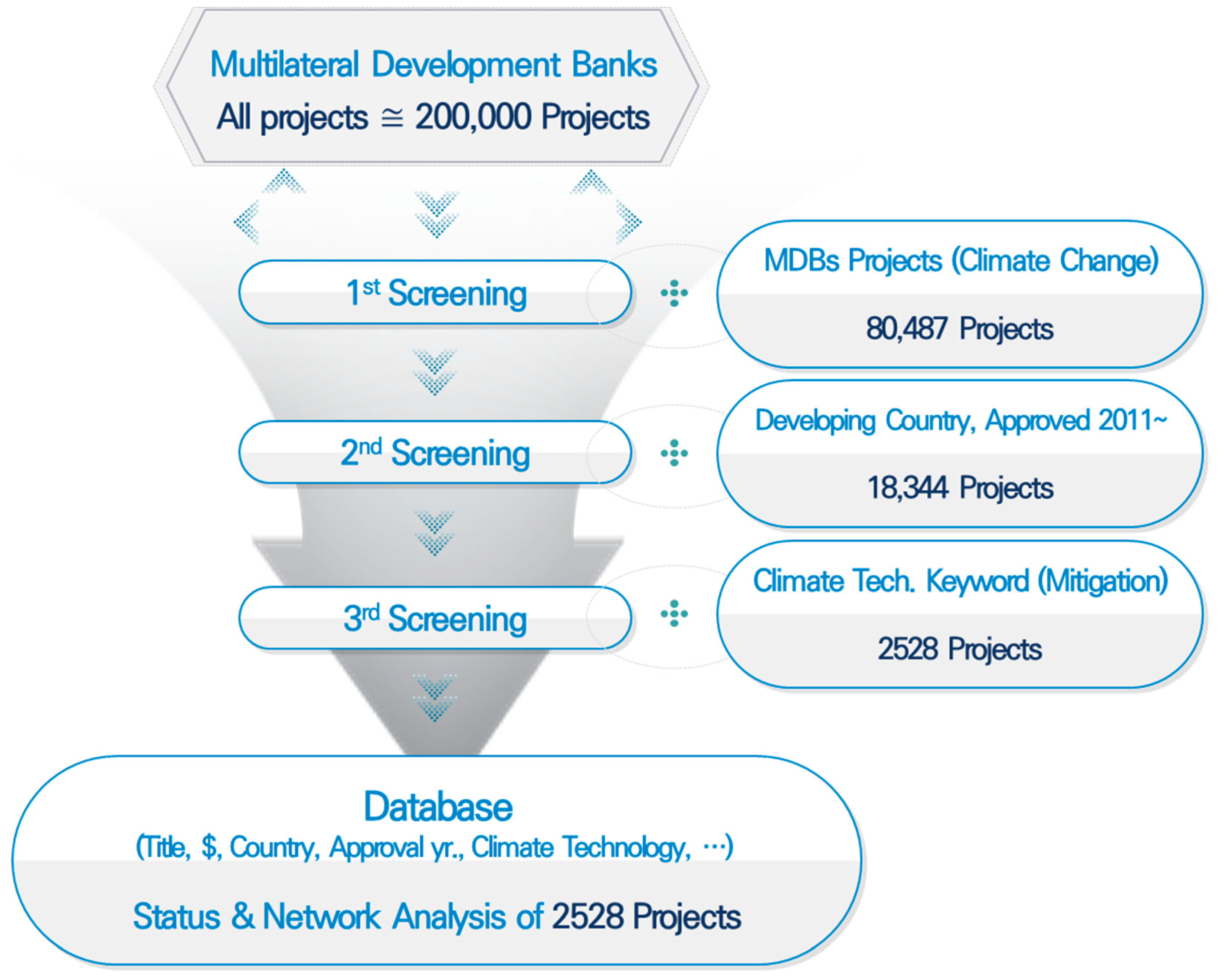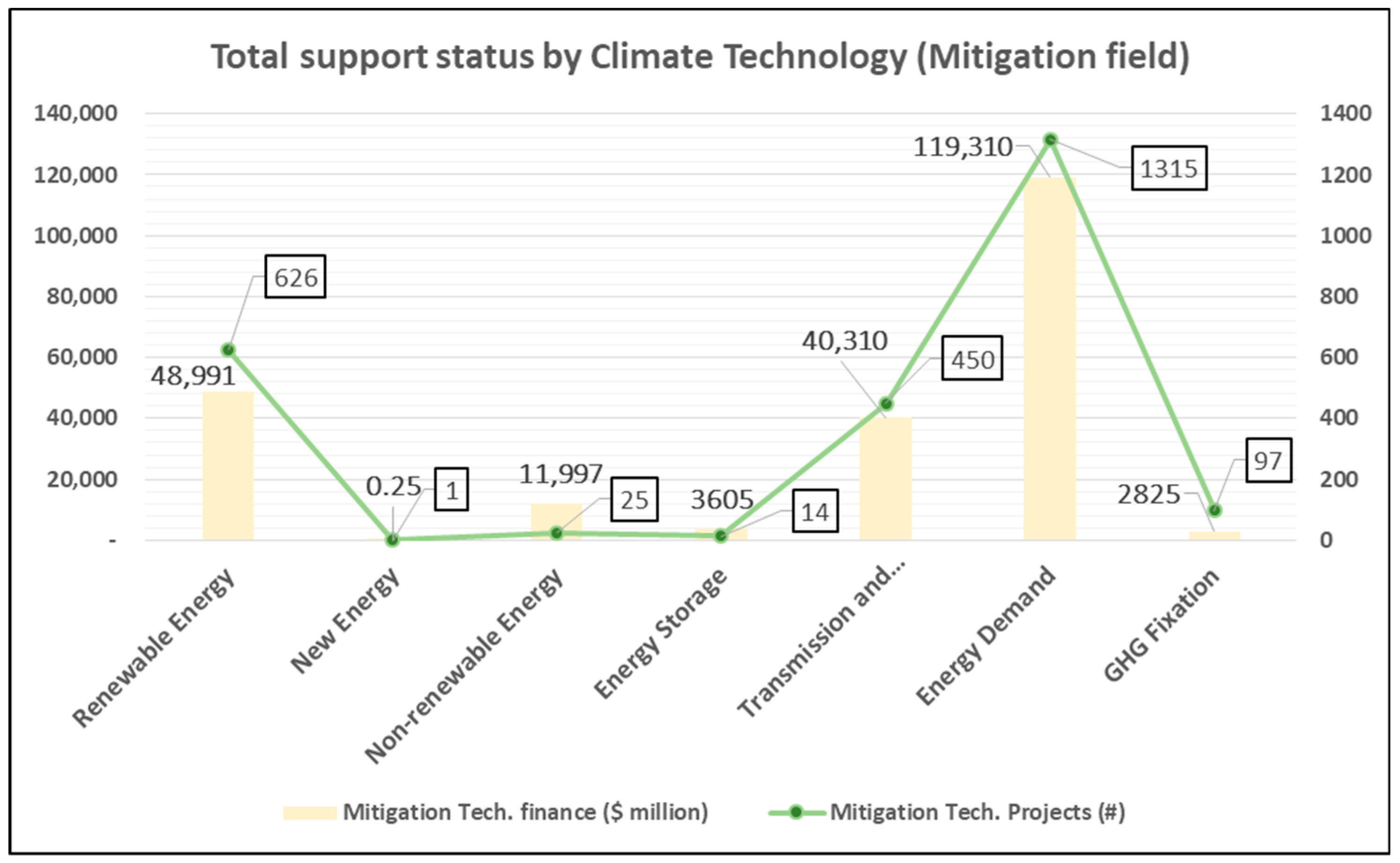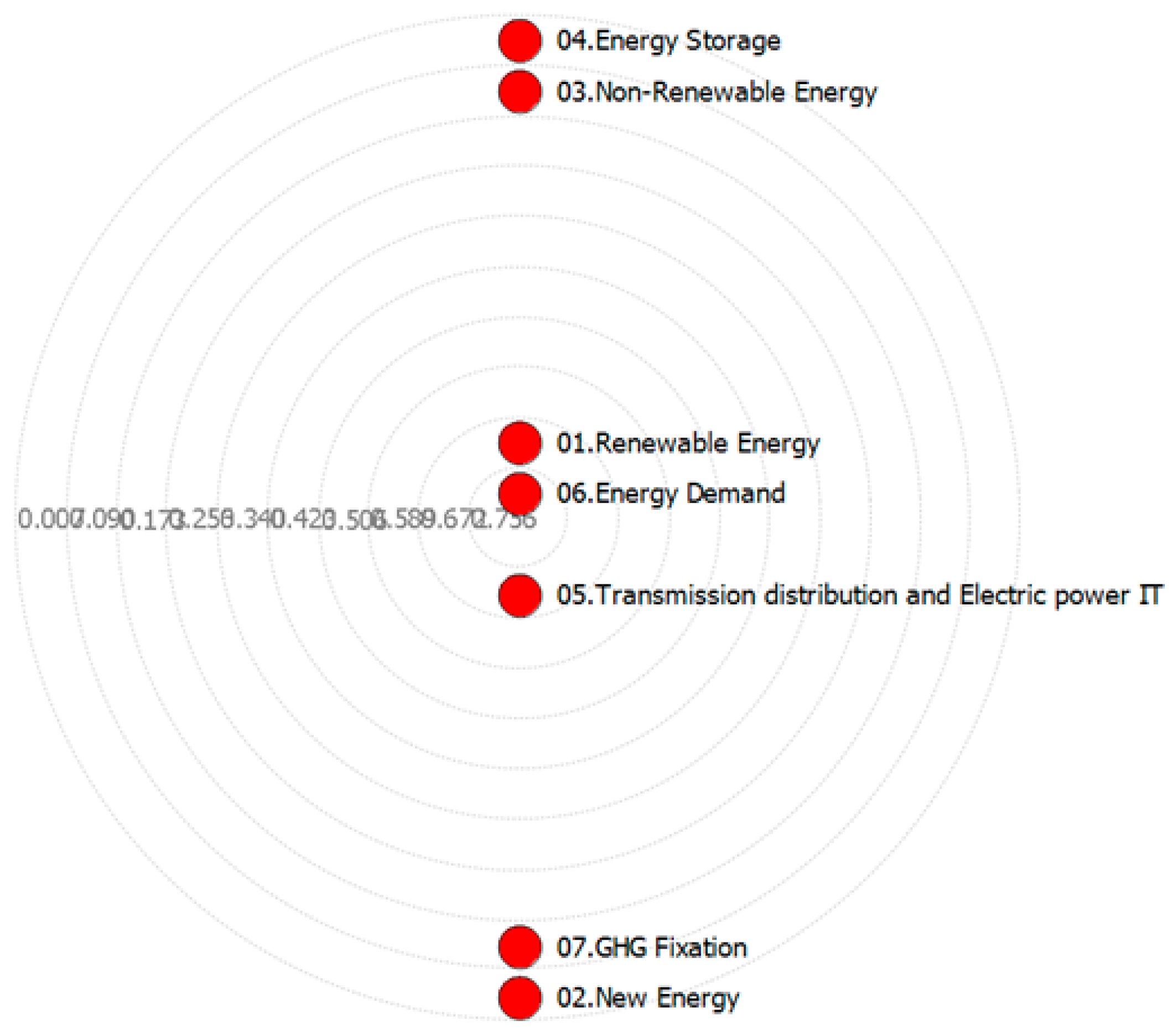Analysis of Climate Mitigation Technology and Finance in Relation to Multilateral Development Banks
Abstract
:1. Introduction
2. Materials and Methods
2.1. Data Collection for Climate Technology Projects of Multilateral Development Banks
2.2. How to Analyze Networks
3. Results and Discussion
3.1. Support from Multilateral Development Banks
3.2. Results of Analysis of MDB, Country, and Technology Network
3.3. Results of Network Analysis, CRI, and Comparison and Analysis of National GHG Emission
4. Conclusions
Author Contributions
Funding
Conflicts of Interest
Appendix A
| MDB | ADB | AfDB | AIIB | EBRD | EIB | IDB | WB | Total | |
|---|---|---|---|---|---|---|---|---|---|
| Technology | |||||||||
| Renewable Energy | 4747 | 1865 | 1246 | 2045 | 3292 | 2224 | 33,571 | 48,991 | |
| 117 | 40 | 4 | 58 | 55 | 198 | 154 | 626 | ||
| New Energy | 0.25 | 0 | |||||||
| 1 | 1 | ||||||||
| Nonrenewable Energy | 504 | 101 | 11,240 | 57 | 19 | 6 | 11,927 | ||
| 4 | 1 | 4 | 1 | 8 | 7 | 25 | |||
| Energy Storage | 484 | 23 | 3098 | 3605 | |||||
| 3 | 4 | 7 | 14 | ||||||
| Transmission and Distribution/Electric Power IT | 12,680 | 4636 | 1629 | 2061 | 1949 | 2733 | 14,623 | 40,310 | |
| 128 | 86 | 5 | 40 | 29 | 65 | 97 | 450 | ||
| Energy Demand | 38,758 | 9639 | 9344 | 7499 | 10,464 | 9731 | 33,874 | 119,310 | |
| 444 | 145 | 18 | 118 | 157 | 279 | 154 | 1315 | ||
| GHG Fixation | 1048 | 190 | 565 | 950 | 73 | 2825 | |||
| 39 | 4 | 2 | 50 | 2 | 97 | ||||
| Total | 57,737 | 16,241 | 23,460 | 11,851 | 16,754 | 15,681 | 85,245 | 226,967 | |
| 732 | 272 | 31 | 221 | 246 | 605 | 421 | 2528 | ||
| Approval Year | 2011 | 2012 | 2013 | 2014 | 2015 | 2016 | 2017 | 2018 | Total | |
|---|---|---|---|---|---|---|---|---|---|---|
| Technology | ||||||||||
| Renewable Energy | 8936 | 4919 | 3641 | 11,840 | 3330 | 4328 | 5607 | 6391 | 48,991 | |
| 79 | 81 | 88 | 81 | 110 | 76 | 90 | 20 | 625 | ||
| New Energy | 0.25 | 0 | ||||||||
| 1 | 1 | |||||||||
| Nonrenewable Energy | 1 | 101 | 1 | 912 | 10,392 | 520 | 11,927 | |||
| 1 | 1 | 2 | 6 | 10 | 5 | 25 | ||||
| Energy Storage | 484 | 0 | 223 | 24 | 19 | 38 | 2818 | 3605 | ||
| 3 | 1 | 4 | 1 | 1 | 1 | 3 | 14 | |||
| Transmission and Distribution/Electric Power IT | 6010 | 4918 | 3437 | 3513 | 4788 | 7927 | 5319 | 3403 | 39,314 | |
| 59 | 47 | 74 | 59 | 52 | 66 | 69 | 22 | 448 | ||
| Energy Demand | 13,929 | 11,870 | 12,160 | 14,913 | 20,617 | 16,214 | 17,312 | 7250 | 114,264 | |
| 177 | 168 | 192 | 177 | 196 | 184 | 151 | 61 | 1306 | ||
| GHG Fixation | 100 | 221 | 695 | 239 | 477 | 28 | 831 | 233 | 2825 | |
| 10 | 14 | 12 | 19 | 10 | 7 | 20 | 5 | 97 | ||
| Total | 28,976 | 22,411 | 20,035 | 30,729 | 29,235 | 29,427 | 39,499 | 20,615 | 220,927 | |
| 326 | 313 | 368 | 342 | 369 | 340 | 342 | 116 | 2516 | ||
References
- A Group of Multilateral Development Banks (MDBs); Joint Report on Multilateral Development Banks’ Climate Finance; European Bank for Reconstruction and Development: London, UK, 2019; pp. 3–8.
- Climate Funds Update. Available online: https://climatefundsupdate.org/about-us/notes-and-methodology/ (accessed on 29 August 2018).
- Green Technology Center; White Paper 2019 on Green Climate Technology. Green Technology Center: Seoul, Korea, 2019. Available online: https://gtck.re.kr/frt/center/en/publications/reports_books.do?pageMode=View&nttId=25734&nowNum=3 (accessed on 8 January 2020).
- Glossary of terms. In Managing the Risks of Extreme Events and Disasters to Advance Climate Change Adaptation—A Special Report of Working Groups I and II of the Intergovernmental Panel on Climate Change (IPCC); Field, C.B.; Barros, V.; Stocker, T.F.; Dahe, Q.; Dokken, D.J.; Ebi, K.L.; Mastrandrea, M.D.; Mach, K.J.; Plattner, G.K.; Allen, S.K.; et al. (Eds.) Cambridge University Press: Cambridge, UK; New York, NY, USA, 2012; pp. 555–564. Available online: https://www.ipcc.ch/site/assets/uploads/2018/03/SREX_Full_Report-1.pdf (accessed on 7 January 2020).
- Climate Change 2007 Impacts, Adaptation and Vulnerability. Contribution of Working Group II to the Fourth Assessment Report of the Intergovernmental Panel on Climate Change; Cambridge University Press: Cambridge, UK, 2007; p. 60. Available online: https://www.ipcc.ch/site/assets/uploads/2018/03/ar4_wg2_full_report.pdf (accessed on 7 January 2020).
- TT: Clear. Available online: https://unfccc.int/ttclear/about (accessed on 7 January 2019).
- Climate Change and Its Impacts in Japan, 2009, Japan Ministry of Education, Culture, Sports, Science and Technology (MEXT); Japan Meteorological Agency (JMA); Ministry of the Environment (MOE). Available online: https://www.env.go.jp/en/earth/cc/report_impacts.pdf (accessed on 7 January 2020).
- Shin, K.N.; Jang, C.S.; Yang, R.W.; Lee, S.K.; Park, I.H.; Kim, Y.I.; Kim, J.M. Climate Technology Center Network and Technical Assistance Guideline; Green Technology Center: Seoul, Korea, 2018; pp. 2–7. Available online: https://gtck.re.kr/frt/center/insight/researchall.do (accessed on 8 January 2020).
- A Group of Multilateral Development Banks (MDBs); Joint Report on Multilateral Development Banks’ Climate Finance; European Bank for Reconstruction and Development: London, UK, 2018; pp. 27–33.
- In-Hwan, O. A Study on the Classification of Climate Technology; Green Technology Center: Seoul, Korea, 2017; Available online: https://gtck.re.kr/frt/center/insight/researchall.do (accessed on 8 January 2020).
- Asian Development Bank. Available online: https://www.adb.org/data/statistics (accessed on 7 January 2020).
- African Development Bank. Available online: https://www.afdb.org/en/projects-and-operations (accessed on 7 January 2020).
- Asian Infrastructure Investment Bank. Available online: https://bankwatch.org/what-we-do#projects (accessed on 7 January 2020).
- European Bank for Reconstruction and Development. Available online: https://www.ebrd.com/work-with-us/project-finance/project-summary-documents.html (accessed on 7 January 2020).
- European Investment Bank. Available online: https://www.eib.org/en/projects/index.htm (accessed on 7 January 2020).
- Inter-American Development Bank. Available online: https://www.iadb.org/en/projects (accessed on 7 January 2020).
- World Bank Group. Available online: https://projects.worldbank.org/ (accessed on 7 January 2020).
- Kwahk, K.Y. Social Network Analysis, 2nd ed.; Chungram Publishing Co., Ltd.: Seoul, Korea, 2017; pp. 417–438. [Google Scholar]
- John, S. Social Network Analysis: A Handbook, 2nd ed.; SAGE Publications: Los Angeles, CA, USA, 2000; p. 224. [Google Scholar]
- NetMiner, version 4.4; Cyram Inc.: Seoul, Korea, 2018.
- Organisation for Economic Co-operation and Development. Available online: https://data.oecd.org/air/air-and-ghg-emissions.htm (accessed on 7 January 2020).
- Eckstein, D.; Hutfils, M.L.; Winges, M. Global Climate Risk Index 2019—Who Suffers Most from Extreme Weather Events? Weather-Related Loss Events in 2017 and 1998 to 2017; Germanwatch: Bonn, Germany, 2018; Available online: https://germanwatch.org/files/Global%20Climate%20Risk%20Index%202019_2.pdf (accessed on 7 January 2020).



| Classification of Climate Technology (Korea) | Keyword for 3rd Screening (Mitigation Technology) | |
|---|---|---|
| Category | Technology Scope | |
| (1) Renewable Energy | Hydropower/Photovoltaic/Solar thermal/Geothermal/Wind power/Ocean energy/Bioenergy/Waste | hydropower, solar, photovoltaic, geothermal, wind power, wind turbine, tidal, wave power, biomass, bioenergy, biogas, waste energy, waste to energy, renewable energy, biofuel, biorefinery (16) |
| (2) New Energy | Hydrogen manufacturing/ Fuel cell | hydrogen production, hydrogen generation, fuel cell (3) |
| (3) Nonrenewable Energy | Nuclear power generation/Fusion power generation/Clean power generation and efficiency | nuclear, atomic, fusion, coal, gasification (5) |
| (4) Energy Storage | Power storage/ Hydrogen storage | energy storage, power storage, hydrogen storage, battery (4) |
| (5) Transmission and Distribution/ Electric Power IT | Transmission and distribution systems/ Electric intelligence devices | smartgrid, microgrid, energy management, power transmission, demand response (5) |
| (6) Energy Demand | Efficient transport/ Industrial efficiency/ Building efficiency | transport, engine, industry, energy efficiency, vehicle, traffic, building, light-emitting diode, life cycle (9) |
| (7) GHG Fixation | CCUS/ Non-CO2 reduction | sequestration, carbon capture, mineralization, combustion capture, geological storage, biological conversion, chemical conversion, nitrous oxide, hydrofluorocarbon, perfluorocarbon, sulfur hexafluoride, nitrogen fluoride three, methane, landfill gas (14) |
| Category of Climate Technology (Mitigation) | # of Projects |
|---|---|
| (1) Renewable Energy | 626 |
| (2) New Energy | 1 |
| (3) Nonrenewable Energy | 25 |
| (4) Energy Storage | 14 |
| (5) Transmission and Distribution/ Electric Power IT | 450 |
| (6) Energy Demand | 1315 |
| (7) GHG Fixation | 97 |
| Total | 2528 |
| MDB | Short-Term (~3 year) | Mid-Term (4~9 year) | Long-Term (more than 10 year ) | Total |
|---|---|---|---|---|
| Renewable Energy | 3360 | 27,934 | 2132 | 33,427 |
| 165 | 165 | 10 | 340 | |
| New Energy | 0 | 0 | 0 | 0 |
| 0 | 0 | 0 | 0 | |
| Nonrenewable Energy | 13 | 9470 | 0 | 9483 |
| 15 | 4 | 0 | 19 | |
| Energy Storage | 225 | 2836 | 0 | 3061 |
| 4 | 4 | 0 | 8 | |
| Transmission and Distribution/Electric Power IT | 5698 | 22,815 | 0 | 28,513 |
| 132 | 196 | 0 | 328 | |
| Energy Demand | 11,391 | 64,318 | 1765 | 77,474 |
| 432 | 438 | 6 | 876 | |
| GHG Fixation | 506 | 679 | 62 | 1248 |
| 52 | 6 | 2 | 60 | |
| Total | 21,193 | 128,053 | 3960 | 153,206 |
| 800 | 813 | 18 | 1631 |
| Rank | Country | Degree Centrality | Rank | Country | Degree Centrality | Rank | Country | Degree Centrality |
|---|---|---|---|---|---|---|---|---|
| 1 | Colombia | 0.857143 | 11 | Guatemala | 0.571429 | 21 | Uruguay | 0.571429 |
| 2 | Regional | 0.857143 | 12 | Cyprus | 0.571429 | 22 | Cote d’Ivoire | 0.571429 |
| 3 | Philippines | 0.714286 | 13 | Russian Federation | 0.571429 | 23 | South Africa | 0.571429 |
| 4 | Mongolia | 0.714286 | 14 | Estonia | 0.571429 | 24 | Brazil | 0.571429 |
| 5 | Vietnam | 0.714286 | 15 | Kazakhstan | 0.571429 | 25 | Rwanda | 0.571429 |
| 6 | Turkey | 0.714286 | 16 | Serbia | 0.571429 | 26 | Peru | 0.571429 |
| 7 | Costa Rica | 0.714286 | 17 | Ecuador | 0.571429 | 27 | Morocco | 0.571429 |
| 8 | Indonesia | 0.714286 | 18 | Dominican Republic | 0.571429 | 28 | Nigeria | 0.571429 |
| 9 | China | 0.714286 | 19 | Kyrgyz Republic | 0.571429 | 29 | Pakistan | 0.571429 |
| 10 | Guyana | 0.571429 | 20 | Argentina | 0.571429 | 30 | Azerbaijan | 0.571429 |
| CRI | Country | O/X * | CRI | Country | O/X * | CRI | Country | O/X * | CRI | Country | O/X * | CRI | Country | O/X* |
|---|---|---|---|---|---|---|---|---|---|---|---|---|---|---|
| 1 | Puerto Rico | X | 21 | Costa Rica | O | 41 | Czech Republic | X | 61 | St. Kitts and Nevis | X | 81 | Solomon Islands | O |
| 2 | Sri Lanka | O | 22 | Latvia | O | 42 | Austria | X | 62 | Ireland | X | 82 | Belgium | X |
| 3 | Dominica | X | 23 | South Africa | O | 43 | Canada | X | 63 | Romania | O | 83 | Côte d’Ivoire | O |
| 4 | Nepal | O | 24 | Albania | O | 44 | Malaysia | X | 64 | Mexico | O | 84 | Papua New Guinea | O |
| 5 | Peru | O | 25 | Nicaragua | O | 45 | Kenya | O | 65 | Slovak Republic | O | 85 | Korea, Republic of | X |
| 6 | Vietnam | O | 26 | Haiti | O | 46 | Ethiopia | O | 66 | Republic of Yemen | X | 86 | Uganda | O |
| 7 | Madagascar | O | 27 | Afghanistan | O | 47 | Spain | X | 67 | Kazakhstan | O | 87 | Rwanda | O |
| 8 | Sierra Leone | O | 28 | Mozambique | O | 48 | Lao People’s Democratic Republic | X | 68 | Paraguay | O | 88 | Saudi Arabia | X |
| 9 | Bangladesh | O | 29 | Poland | X | 49 | Argentina | O | 69 | Myanmar | O | 89 | Jamaica | O |
| 10 | Thailand | O | 30 | Greece | X | 50 | Indonesia | O | 70 | New Zealand | X | 90 | Chinese Taipei | X |
| 11 | Portugal | X | 31 | China | O | 51 | Zimbabwe | X | 71 | Russia | X | 91 | Slovenia | O |
| 12 | USA | X | 32 | Serbia | O | 52 | Kyrgyz Republic | O | 72 | Turkey | O | 92 | Tanzania | O |
| 13 | Antigua and Barbuda | X | 33 | Pakistan | O | 53 | Bulgaria | O | 73 | Guatemala | O | 93 | Ghana | O |
| 14 | India | O | 34 | Honduras | O | 54 | Croatia | O | 74 | The Bahamas | X | 94 | Liberia | O |
| 15 | Niger | O | 35 | Italy | X | 55 | Switzerland | X | 75 | Botswana | X | 95 | Tunisia | O |
| 16 | Chile | X | 36 | Japan | X | 56 | Democratic Republic of Congo | O | 76 | Burundi | O | 96 | Central African Republic | X |
| 17 | Ecuador | O | 37 | Dominican Republic | O | 57 | Malawi | O | 77 | Panama | O | 97 | Fiji | O |
| 18 | Australia | X | 38 | Iran | X | 58 | Bosnia and Herzegovina | O | 78 | Mauritania | X | 98 | Angola | O |
| 19 | Colombia | O | 39 | Bolivia | O | 59 | France | X | 79 | Brazil | O | 99 | El Salvador | O |
| 20 | Philippines | O | 40 | Germany | X | 60 | Sudan | X | 80 | Nigeria | O | 100 | Cyprus | O |
© 2020 by the authors. Licensee MDPI, Basel, Switzerland. This article is an open access article distributed under the terms and conditions of the Creative Commons Attribution (CC BY) license (http://creativecommons.org/licenses/by/4.0/).
Share and Cite
Lee, J.Y.; Han, S.H. Analysis of Climate Mitigation Technology and Finance in Relation to Multilateral Development Banks. Energies 2020, 13, 311. https://doi.org/10.3390/en13020311
Lee JY, Han SH. Analysis of Climate Mitigation Technology and Finance in Relation to Multilateral Development Banks. Energies. 2020; 13(2):311. https://doi.org/10.3390/en13020311
Chicago/Turabian StyleLee, Joo Young, and Su Hyeon Han. 2020. "Analysis of Climate Mitigation Technology and Finance in Relation to Multilateral Development Banks" Energies 13, no. 2: 311. https://doi.org/10.3390/en13020311
APA StyleLee, J. Y., & Han, S. H. (2020). Analysis of Climate Mitigation Technology and Finance in Relation to Multilateral Development Banks. Energies, 13(2), 311. https://doi.org/10.3390/en13020311




